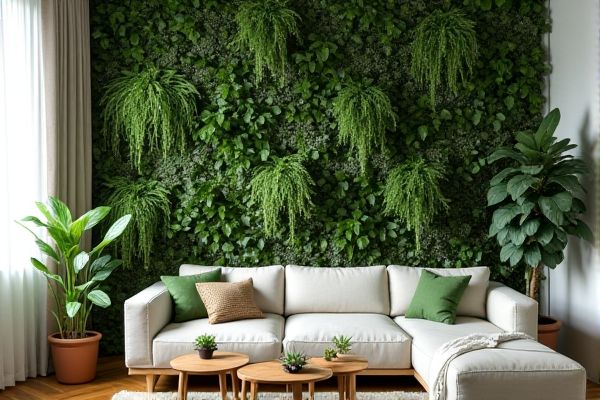
Artificial plant walls offer low maintenance and consistent aesthetic appeal without the need for watering or sunlight, while live plant walls promote air purification and natural ambiance with the added benefit of enhancing indoor air quality. Explore the rest of the article to understand which option best suits Your space and lifestyle.
Table of Comparison
| Feature | Artificial Plant Wall | Live Plant Wall |
|---|---|---|
| Maintenance | Low - No watering or trimming required | High - Regular watering, pruning, and care needed |
| Cost | Lower initial cost, minimal upkeep expenses | Higher initial and ongoing maintenance costs |
| Air Quality | No air purification benefits | Improves air quality by absorbing CO2 and pollutants |
| Lifespan | Long-lasting, color stable | Variable; dependent on plant species and care |
| Aesthetic Appeal | Consistent look, no seasonal changes | Natural appearance with seasonal variation |
| Installation | Quick and easy to install | Requires expert installation and setup |
| Environmental Impact | Made from synthetic materials, limited biodegradability | Supports biodiversity and improves environment |
| Humidity Regulation | No impact on humidity | Increases indoor humidity naturally |
Introduction to Plant Walls: Artificial vs Live
Artificial plant walls offer a maintenance-free option that retains vibrant color and structure year-round, making them ideal for indoor environments with limited natural light. Live plant walls improve air quality by naturally filtering pollutants, promoting wellness and a connection to nature through real foliage and growth. Choosing between artificial and live plant walls depends on your space's lighting conditions, maintenance capacity, and desired environmental benefits.
Visual Appeal and Aesthetics Comparison
Artificial plant walls maintain consistent color and shape year-round, providing a polished and low-maintenance aesthetic suitable for modern interiors. Live plant walls offer dynamic visual appeal through natural growth patterns, seasonal changes, and organic textures that enhance biophilic design. Both options contribute distinct aesthetic qualities, with live plants delivering authenticity and air-purifying benefits, while artificial walls ensure durability and design flexibility.
Installation Process: Ease and Requirements
Artificial plant walls require minimal installation efforts, often involving lightweight panels that can be mounted on most surfaces with basic tools and no need for watering or specialized maintenance systems. Live plant walls demand a more complex installation, including structural support, irrigation systems, and ongoing access for plant care, making the setup time-consuming and requiring horticultural expertise. Your choice depends on whether you prioritize quick installation and low upkeep or prefer the natural air-purifying benefits and aesthetic of living plants.
Maintenance and Upkeep Differences
Artificial plant walls require minimal maintenance, needing only occasional dusting and cleaning, whereas live plant walls demand consistent watering, pruning, and monitoring for pests and diseases. Live plant walls improve air quality and contribute to a healthier environment but involve higher labor and resource investment. Your choice depends on balancing aesthetic appeal with the level of ongoing care you are prepared to commit.
Environmental Impact and Sustainability
Artificial plant walls require no water, pesticides, or maintenance, significantly reducing resource consumption and chemical runoff compared to live plant walls. However, they are typically made from non-biodegradable plastics that contribute to landfill waste and have a higher carbon footprint due to manufacturing and transportation processes. Live plant walls improve air quality, support biodiversity, and sequester carbon, promoting ecosystem health and sustainability despite needing ongoing care and water resources.
Cost Analysis: Initial and Long-Term Expenses
Artificial plant walls require a lower initial investment compared to live plant walls, which often involve higher startup costs for soil, irrigation systems, and plant selection. Over time, live plant walls incur ongoing expenses such as watering, pruning, pest control, and potential plant replacement, leading to increased long-term maintenance costs. Your decision should weigh the upfront savings of artificial walls against the environmental benefits and dynamic growth of live plant installations.
Benefits for Indoor Air Quality
Live plant walls significantly improve indoor air quality by naturally filtering pollutants and increasing oxygen levels through photosynthesis. Artificial plant walls, while offering aesthetic appeal without maintenance, do not contribute to air purification or oxygen production. Your choice impacts the indoor environment's air health, with live plant walls providing substantial benefits for cleaner, fresher air.
Longevity and Durability
Artificial plant walls offer superior longevity and durability compared to live plant walls, as they are resistant to environmental factors like sunlight, humidity, and pests that can damage living plants. Unlike live plant walls, which require regular maintenance, watering, and replacement of dead plants, artificial walls maintain their appearance without ongoing care. You can invest in artificial plant walls for a long-lasting, low-maintenance solution that preserves aesthetic appeal year-round.
Customization Options and Design Flexibility
Artificial plant walls offer extensive customization options, allowing you to choose from a wide variety of colors, shapes, and materials that remain consistent over time without maintenance. Live plant walls provide natural variation and seasonal changes, enhancing aesthetic appeal but requiring careful selection of plant species to thrive in specific environments. Design flexibility is higher with artificial walls, as they can be installed in spaces with limited light and humidity control, whereas live walls depend heavily on environmental conditions and irrigation systems.
Choosing the Right Plant Wall for Your Space
Artificial plant walls require minimal maintenance, offer consistent aesthetics, and are ideal for spaces lacking natural light or with stringent upkeep constraints. Live plant walls improve air quality, promote well-being, and create a dynamic, evolving environment that adjusts with seasonal changes. Your choice depends on factors like light availability, maintenance capacity, and the desired ambiance for your space.
 homyna.com
homyna.com